| ________________
CM . . . . Volume XX Number 18 . . . . January 10, 2014

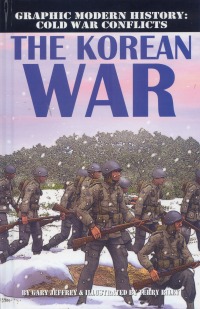
|
The Korean War. (Graphic Modern History: Cold War Conflicts).
Gary Jeffrey. Illustrated by Tom Riley.
St. Catharines, ON: Crabtree, 2013.
48 pp., pbk., hc., pdf & html, $11.95 (pbk.), $21.56 (RLB.).
ISBN 978-0-7787-1238-1 (pbk.), ISBN 978-0-7787-1234-3 (RLB.), ISBN 978-1-4271-9345-2 (pdf), ISBN 978-1-4271-9341-4 (html).
Subject Headings:
Korean War, 1950-1953-Juvenile literature.
Korean War, 1950-1953-Comic books, strips, etc-Juvenile literature.
Graphic novels.
Grades 5-8 / Ages 10-13.
Review by Dave Jenkinson.
*** /4
|
| |
|
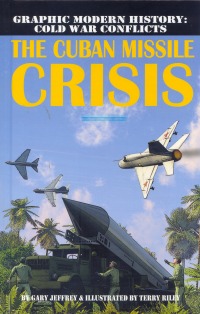
|
The Cuban Missile Crisis. (Graphic Modern History: Cold War Conflicts).
Gary Jeffrey. Illustrated by Tom Riley.
St. Catharines, ON: Crabtree, 2013.
48 pp., pbk., hc., pdf & html, $11.95 (pbk.), $21.56 (RLB.).
ISBN 978-0-7787-1237-4 (pbk.), ISBN 978-0-7787-1233-6 (RLB.), ISBN 978-1-4271-9344-5 (pdf), ISBN 978-1-4271-9340-7 (html).
Subject Headings:
Cuban Missile Crisis -1962-Juvenile literature.
Cuban Missile Crisis-1962 -Comic books, strips, etc-Juvenile literature.
Cuba-History-Invasion, 1961-Juvenile literature.
Cuba-History-Invasion, 1961-Comic books, strips, etc-Juvenile literature.
Cuba-History-Revolution, 1959-Juvenile literature.
Cuba-History-Revolution, 1959-Comic books, strips, etc-Juvenile literature.
Graphic novels.
Grades 5-8 / Ages 10-13.
Review by Dave Jenkinson.
*** /4
|
| |
|
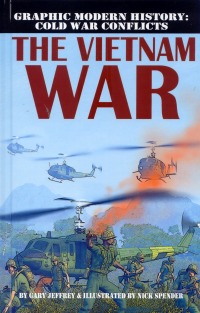
|
The Vietnam War. (Graphic Modern History: Cold War Conflicts).
Gary Jeffrey. Illustrated by Nick Spender.
St. Catharines, ON: Crabtree, 2013.
48 pp., pbk., hc., pdf & html, $11.95 (pbk.), $21.56 (RLB.).
ISBN 978-0-7787-1240-4 (pbk.), ISBN 978-0-7787-1236-7 (RLB.), ISBN 978-1-4271-9347-6 (pdf), ISBN 978-1-4271-9343-8 (html).
Subject Headings:
Vietnam War, 1961-1975-1962-Juvenile literature.
Vietnam War, 1961-1975 -Comic books, strips, etc-Juvenile literature.
Graphic novels.
Grades 5-8 / Ages 10-13.
Review by Dave Jenkinson.
*** /4
|
| |
|
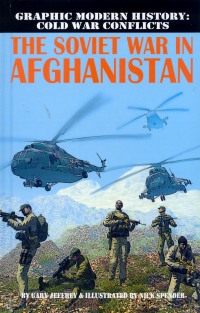
|
The Soviet War in Afghanistan. Graphic Modern History: Cold War Conflicts).
Gary Jeffrey. Illustrated by Nick Spender.
St. Catharines, ON: Crabtree, 2013.
48 pp., pbk., hc., pdf & html, $11.95 (pbk.), $21.56 (RLB.).
ISBN 978-0-7787-1239-8 (pbk.), ISBN 978-0-7787-1235-0 (RLB.), ISBN 978-1-4271-9346-9 (pdf), ISBN 978-1-4271-9342-1 (html).
Subject Headings:
Afghanistan-History-Soviet Occupation, 1979-1989-Juvenile literature.
Afghanistan-History-Soviet Occupation, 1979-1989-Comic books, strips, etc-Juvenile literature.
Graphic novels.
Grades 5-8 / Ages 10-13.
Review by Dave Jenkinson.
*** /4
|
| |
|

excerpt:
Carved Up
When Soviet forces invaded Japanese-held Manchuria in 1945, they advanced into northern Korea. Japan surrendered the rest of Korea to the Allies. Soviet leader Joseph Stalin agreed to divide control of Korea with the United States at the 38th parallel. This period marks the beginning of the Cold War between the United States and the Soviet Union. Although the two countries did not engage in battle directly, they competed instead for control or influence over other countries.
The United States had emerged from the war as the leading world superpower. Stalin wanted North Korea to be a communist buffer zone against American influence.
Meanwhile each of the new leaders in both North and South Korea considered themselves to be the rightful ruler of all of Korea. The North attempted to overthrow the South by funding insurgents. The communist uprising was brutally put down by South Korea. (From The Korean War.)
On March 5, 1946, Sir Winston Churchill, the ex-Prime Minister of Great Britain, gave a speech in the United States in which he uttered the now famous line: ""From Stettin in the Baltic to Trieste in the Adriatic, an iron curtain has descended across the Continent." This speech is often credited as marking the beginning of the Cold War between the Western and Eastern Blocs, i.e. the United States and the USSR, plus their political and military allies. Beginning in 1947 and continuing until the dissolution of the USSR in 1991, the Cold War, a political conflict, sometimes found its expression in military action. The four books in the "Cold War Conflicts", a subset of the "Graphic Modern History" series, look at four such military confrontations.
Think of each of the four books in the "Graphic Modern History: Cold War Conflicts" series as being a history sandwich. The sandwich's two slices of bread, which include a map and photographs, consist of the four pages of factual "dry" history that appear at the beginning of the book and the two pages that are found at the end. In general terms, the first history "slice" sets up the particular conflict while the closing "slice" provides the outcomes. The sandwich's filling consists of a retelling of three personal "incidents" that occurred during the conflict, with each being told in graphic novel style. As is the case with many actual sandwiches, in the "Cold War Conflicts" books, it is the filling that will likely be most "tasty" to middle school readers.
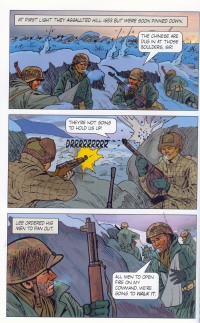 In the filling portion of "The Korean War", Jeffrey first tells the story of an American F-51 Mustang pilot who, on September 4, 1950, had to bail out of his aircraft after it was hit by North Korean groundfire, and who was then rescued behind enemy lines by a helicopter. The next episode deals with an American column of Marines that was sent in on the night of December 2, 1950, to relieve Fox Company whose defensive position at the Chosin Reservoir was in danger of being overrun by Chinese forces. The final story takes place in the air on September 15, 1952, over the Yalu River in Northwest Korea as US Air Force Captain Robinson Risner, the pilot of an F-86 jet fighter, shoots down two Mig-15s.
In the filling portion of "The Korean War", Jeffrey first tells the story of an American F-51 Mustang pilot who, on September 4, 1950, had to bail out of his aircraft after it was hit by North Korean groundfire, and who was then rescued behind enemy lines by a helicopter. The next episode deals with an American column of Marines that was sent in on the night of December 2, 1950, to relieve Fox Company whose defensive position at the Chosin Reservoir was in danger of being overrun by Chinese forces. The final story takes place in the air on September 15, 1952, over the Yalu River in Northwest Korea as US Air Force Captain Robinson Risner, the pilot of an F-86 jet fighter, shoots down two Mig-15s.
Although Canada provided the third largest number of combat troops amongst the allied forces in the Korean War, the closest Canada gets to even being mentioned in this book is found in the sentence, "The United Nations agreed to send the United Nations Corps (UNC) – an international force, but mostly American – to aid a South Korean army...' (p. 3). Given that Crabtree is a Canadian publisher, and given that July 27, 2013, marked the 60th anniversary of the signing of Korean War-ending Armistice Agreement and was designated Korean War Veterans' Day in Canada, it is unfortunate that Crabtree did not give one of the graphic portions over to a Canadian 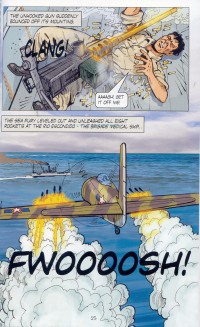 engagement, such as the April 24, 1951 Battle of Kapyong. engagement, such as the April 24, 1951 Battle of Kapyong.
Though the Cuban Missile Crisis occurred in October, 1962, two of the three graphic tales in The Cuban Missile Crisis actually took place prior to that event. The first, "The Battle of Santa Clara" that took place on December 28, 1958, sees Cuban dictator Batista sending 300 men by train to bolster his troops in Santa Clara, his last major line of defense before Fidel Castro's revolutionaries, led by Che Guevara, can march on the capital city of Havana. The second story, "The Bay of Pigs Invasion" of April 17, 1961, jumps around in its telling of this failed US backed counter-revolutionary invasion of Castro's Cuba by Cuban exiles. Only the final entry deals directly with the actual "title" subject of the book, and it focuses principally on the political maneuverings in Washington rather than any "action." In fact, "The Cuban Missile Crisis, 1962" is the only entry in the four books being reviewed that actually contains any truly "hard" history.
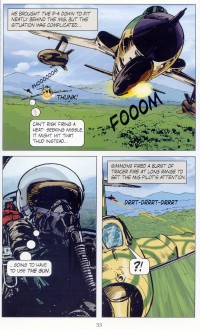 Combat is front and centre in the three graphic stories in The Vietnam War. In "Rescue at LZ Albany", two companies of American soldiers had been ambushed, and, in the middle of the night of November 17, 1965, they are requesting that a helicopter be dispatched to bring them more ammunition and to evacuate their wounded. When the Medivac pilots won't fly because the LZ (Landing Zone) is "too hot", a pilot from an Assault Helicopter unit volunteers to make the dangerous flight. "Close Call in the Street Without Joy" deals with a battalion of Marines who, in February, 1967, are dealing with a road that is constantly being mined by the Viet Cong. The last story, "Double Gun Kill", which took place in the skies over North Vietnam on November 6, 1967, sees Captain Darrell Simmons, shooting down two Mig-17s.
Combat is front and centre in the three graphic stories in The Vietnam War. In "Rescue at LZ Albany", two companies of American soldiers had been ambushed, and, in the middle of the night of November 17, 1965, they are requesting that a helicopter be dispatched to bring them more ammunition and to evacuate their wounded. When the Medivac pilots won't fly because the LZ (Landing Zone) is "too hot", a pilot from an Assault Helicopter unit volunteers to make the dangerous flight. "Close Call in the Street Without Joy" deals with a battalion of Marines who, in February, 1967, are dealing with a road that is constantly being mined by the Viet Cong. The last story, "Double Gun Kill", which took place in the skies over North Vietnam on November 6, 1967, sees Captain Darrell Simmons, shooting down two Mig-17s.
Canadian youth may be aware that our nation's armed forces have been involved in the recent military conflict in Afghanistan, but likely most won't know that the USSR fought its own war in this nation between 1979 and 1987. "Firefight in the Battle for Kama", which occurred on February 15, 1983, follows a group of Mujahideen as they engage Russian troops that are superior in both numbers and equipment. The perspective changes in "Assault on the Panjshir Valley" as a unit of motorized Soviet troops are ordered on April 30, 1984, to clear a ravine and are ambushed by the Mujahideen who are hidden in the rock terrace above them. The final story, "Stinger vs Hind", again returns to the Afghan fighters who, on September 26, 1986, get their first combat opportunity to use CIA-supplied Stinger missiles against the heavily armored Soviet MI-24 helicopter gunships that had been harassing them with impunity over the previous seven years.
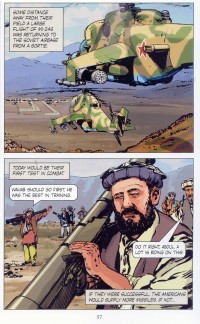 The artwork supplied by both Riley and Spender for the graphic novel portions of the four books is excellent and captures the action well. As is standard practice in Crabtree books, each book closes with a "Glossary" and an "Index". Neither of these features is really necessary in these titles, and the three pages could have been given over to a bit more "hard" history.
The artwork supplied by both Riley and Spender for the graphic novel portions of the four books is excellent and captures the action well. As is standard practice in Crabtree books, each book closes with a "Glossary" and an "Index". Neither of these features is really necessary in these titles, and the three pages could have been given over to a bit more "hard" history.
It's doubtful that most middle school students will learn a great deal about the Cold War from this quartet of titles, but the graphic novel portions might awaken some interest in history.
Recommended.
Dave Jenkinson, CM's editor, lives in Winnipeg, MB.

To comment
on this title or this review, send mail to cm@umanitoba.ca.
Copyright © the Manitoba Library Association. Reproduction for personal
use is permitted only if this copyright notice is maintained. Any
other reproduction is prohibited without permission.
NEXT REVIEW |
TABLE OF CONTENTS FOR THIS ISSUE
- January 10, 2014.
AUTHORS |
TITLES |
MEDIA REVIEWS |
PROFILES |
BACK ISSUES |
SEARCH |
CMARCHIVE |
HOME |




 In the filling portion of "The Korean War", Jeffrey first tells the story of an American F-51 Mustang pilot who, on September 4, 1950, had to bail out of his aircraft after it was hit by North Korean groundfire, and who was then rescued behind enemy lines by a helicopter. The next episode deals with an American column of Marines that was sent in on the night of December 2, 1950, to relieve Fox Company whose defensive position at the Chosin Reservoir was in danger of being overrun by Chinese forces. The final story takes place in the air on September 15, 1952, over the Yalu River in Northwest Korea as US Air Force Captain Robinson Risner, the pilot of an F-86 jet fighter, shoots down two Mig-15s.
In the filling portion of "The Korean War", Jeffrey first tells the story of an American F-51 Mustang pilot who, on September 4, 1950, had to bail out of his aircraft after it was hit by North Korean groundfire, and who was then rescued behind enemy lines by a helicopter. The next episode deals with an American column of Marines that was sent in on the night of December 2, 1950, to relieve Fox Company whose defensive position at the Chosin Reservoir was in danger of being overrun by Chinese forces. The final story takes place in the air on September 15, 1952, over the Yalu River in Northwest Korea as US Air Force Captain Robinson Risner, the pilot of an F-86 jet fighter, shoots down two Mig-15s.
 engagement, such as the April 24, 1951 Battle of Kapyong.
engagement, such as the April 24, 1951 Battle of Kapyong.  Combat is front and centre in the three graphic stories in The Vietnam War. In "Rescue at LZ Albany", two companies of American soldiers had been ambushed, and, in the middle of the night of November 17, 1965, they are requesting that a helicopter be dispatched to bring them more ammunition and to evacuate their wounded. When the Medivac pilots won't fly because the LZ (Landing Zone) is "too hot", a pilot from an Assault Helicopter unit volunteers to make the dangerous flight. "Close Call in the Street Without Joy" deals with a battalion of Marines who, in February, 1967, are dealing with a road that is constantly being mined by the Viet Cong. The last story, "Double Gun Kill", which took place in the skies over North Vietnam on November 6, 1967, sees Captain Darrell Simmons, shooting down two Mig-17s.
Combat is front and centre in the three graphic stories in The Vietnam War. In "Rescue at LZ Albany", two companies of American soldiers had been ambushed, and, in the middle of the night of November 17, 1965, they are requesting that a helicopter be dispatched to bring them more ammunition and to evacuate their wounded. When the Medivac pilots won't fly because the LZ (Landing Zone) is "too hot", a pilot from an Assault Helicopter unit volunteers to make the dangerous flight. "Close Call in the Street Without Joy" deals with a battalion of Marines who, in February, 1967, are dealing with a road that is constantly being mined by the Viet Cong. The last story, "Double Gun Kill", which took place in the skies over North Vietnam on November 6, 1967, sees Captain Darrell Simmons, shooting down two Mig-17s.
 The artwork supplied by both Riley and Spender for the graphic novel portions of the four books is excellent and captures the action well. As is standard practice in Crabtree books, each book closes with a "Glossary" and an "Index". Neither of these features is really necessary in these titles, and the three pages could have been given over to a bit more "hard" history.
The artwork supplied by both Riley and Spender for the graphic novel portions of the four books is excellent and captures the action well. As is standard practice in Crabtree books, each book closes with a "Glossary" and an "Index". Neither of these features is really necessary in these titles, and the three pages could have been given over to a bit more "hard" history.